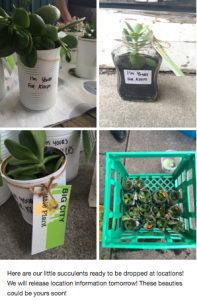For the final leg of my Integrated Media Specialisation, a group of students and myself constructed an event in order to produce an interactive online documentary. After conducting research for our event idea, we developed the concept for ‘Big City, Little Plant’ (BCLP). We were inspired by a guerrilla organisation called ‘aMoments’. The group is known globally for instigating feel-good discoveries that take place in public spaces. Our group decided to run a similarly themed, feel-good event that would also occur in communal spaces.
aMoments at Liverpool Street Station, London
The aim of the BCLP was to promote green-living to publics who live or work in urban spaces or gentrified areas, as various studies have shown that having green-life in your office or home can increase personal creativity and productivity. Importantly, the team considered how we could critically engage an audience through use of social media by holding an event that aimed to encourage members of the public to introduce green-life into their work and living spaces. We aimed for the event to entice members of the public to share their experience as a part of their everyday online activity. With these factors in mind, our team created around 100 small pot plants with succulents that were produced from recycled materials that contained labelled instructions on how to get involved. The pot plants were placed in predetermined locations in and around Melbourne’s CBD for passer-by’s to discover and engage with the initiative online.
Our team established the BCLP brand for the pot plants to enable our key messages to reach our targeted audiences and ultimately to entice spectators to engage with the project online. We used Social Networking Sites (SNS) in combination with researched locations in order to gain ongoing participation from our audience. Additionally, we wanted to explore and bridge the gap between independent pot plant discoveries and online engagement. We envisioned that the discovery of a marked pot plant found in an independent, pubic space would provoke an element of curiosity within an individual and they would proceed to engage with BCLP online.
Our group was focused on producing an interactive documentary that would be sparked from our event and implemented strategies to foster this. As the Project Manager, I identified potential themes within BCLP that might be of interest to our target audiences and utilized these elements to encourage continual participation. I found that the main elements within our project were; green-living, urban spaces, sustainability and crafting. By identifying the underlying themes, our group was able to develop them as well as integrate them into our branding, online content and the overall direction of our project. This also assisted our group in conceptualising BCLP’s website and to consider how we could stimulate participation through the themes.
After the event played through and online engagement wound down, our team actualised the website. The website was based around the core themes within our project and also documented the overall participation and conclusions we gained from hosting the event.
For the meantime, here are few of our favourite pot plants that were placed in some lucky keeper’s homes and work spaces.


